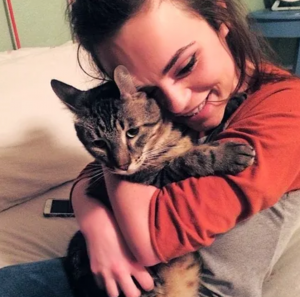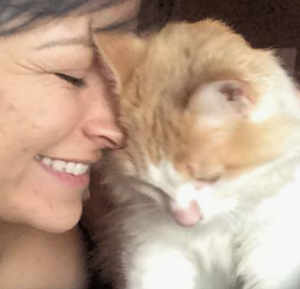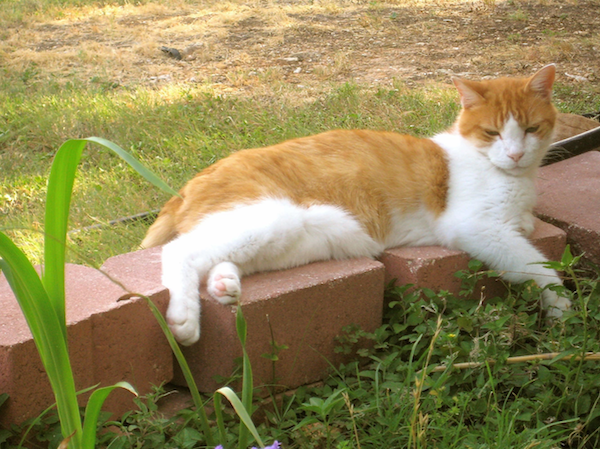by Kim Freeman, The Cat Detective
As a professional Lost Cat Finder, I always see an increase in lost cat cases around the holidays. One of the most common reasons for a cat’s disappearance is an open door, whether from a distracted pet sitter, careless kids or even packing for a trip. With the general chaos of guests coming and going, keep your cat safe and be ready should the worst happen.
Cats are harder to recover than dogs and require special techniques beyond flyers on posts and a visit to the shelter. Would you know what to do if a pet sitter or visitor left a door open and your cat escaped? Take these steps to prevent your cat from ever going missing. This emergency situation can happen to even the best and most careful owners.
Learn Your Cat’s Habits
Get to know when your cat sleeps, what hours they are the most active, and note whether they prefer to be up in high places or down low. All this will be useful info should your cat ever get out.
Have Your Search Zone Ready
If you have an indoor-only cat, be ready with a map of where to search. With indoor cats who escape, they are most often hiding within a 250-foot radius of the escape point. Outdoor access cats have a larger territory, so they are going to be usually within a 800-foot radius. Use Google maps to outline your home and search circle so you are ready if they get out.
Safe Transport
This sounds basic, but you’d be surprised how many pet owners put their cats at risk. A cat inside a car can escape when involved in a traffic accident, or jump out prematurely when a door is opened (see the case of this cat slipping out at gas station at night). Cat carriers have been known to break open during traffic accidents, in vet parking lots, and on conveyor belts at airports. No matter how crabby your cat becomes with confinement, make sure you transport him/her in a secure carrier.
Have Photos Ready
Keep a recent photo of your cat on hand showing their face and body markings in case you need the photo for a lost cat flyer and poster. The ideal photo for a lost cat poster is against a plain background with your cat in a standing or sitting side view. One big photo is better than two hard to see small ones. Sitting or standing is key as it is the position strangers would most likely see them out in the world.
Prepare a Lost Cat Kit
 Store photos, microchip number and a mock-up lost cat flyer where they’re easy to access. Should you ever need them, this kit will save you precious time and stress. The best preparation is to at least skim the ebook and video “How to Find a Lost Cat” so you can swing into action immediately and know the appropriate steps for your situation and the common mistakes to avoid (like putting out food or cat litter).
Store photos, microchip number and a mock-up lost cat flyer where they’re easy to access. Should you ever need them, this kit will save you precious time and stress. The best preparation is to at least skim the ebook and video “How to Find a Lost Cat” so you can swing into action immediately and know the appropriate steps for your situation and the common mistakes to avoid (like putting out food or cat litter).
GPS Trackers
It seems like GPS on a collar would good for those adventurous cats who like to roam, but so far, they are still fairly heavy bulky and depend on open sky. There are several devices on the market including the unwieldy Whistle, but based on my clients’ lost cats, I’ve found that RF technology works the best in terms of finding a cat’s exact location. Glow Track collars are ideal as they light up and offer an RF tracking option.
Collar & Microchip
Even if you never let your cat out, you never know when an emergency will happen and your cat escapes. A visitor may leave the door open, cat carriers can break, a visitor could leave a window open or a burglar could break into your home, leaving the door open for your cat to escape outside. Paramedics could have to go to your or a relative’s home, and leave the door open during an emergency procedure.
I’ve even seen pets ejected from cars in traffic accidents. Most people never think these events could happen to them. But even indoor-only cats should wear a collar, tag and microchip because if they escape outside, they’re at risk of ultimately ending up in an animal shelter long after you have stopped searching.
Micro-chipping is equivalent to implanting a serial number in your pet as a means to return property to their rightful owner. Microchips are not GPS trackers they are for Identification, detectable with a microchip scanner used by shelters, veterinarians, and rescue groups. Make sure your cat is micro-chipped and especially make sure that chip is registered to YOU at your CURRENT address and phone number.
Proof of Ownership
Be able to demonstrate proof that you own your cat, as there is no guarantee the person who finds your pet will be willing to give it back to you. You will need to have something to show an officer to prove that this animal belongs to you. The best method to show proof of ownership is to have your pet microchipped. Check with your local shelter, rescue groups, and veterinarians to have this simple procedure performed (a shot where a microchip the size of a rice grain is implanted under your pet’s skin). If your pet has any special markings, markings inside their mouth, scars, tattoos, etc., photograph these areas and keep these photos in a special location with your cat’s vet records.
Keep Photos With Your Vet
It is a good idea to keep a set of records and current pet photos with your veterinarian (they can be attached to your pet’s file). This way, your pet’s photo will be available should your home be destroyed (during fire or flood) or if the photos you kept at home get lost or destroyed.
Be Neighborly
 Make sure your neighbors know you have a cat whether your cat is indoor only or outdoor access. That way, if your cat ever escapes they will know who it belongs to and will be more likely to rescue and return it to you when they see it. Also, being a good neighbor will increase the chances that your neighbors will help when your pet becomes lost. If your cat routinely roams and stalks birds or poops on neighbor property, make sure you have preempted any complaints by asking neighbors to let you know if your cat is a problem for them in any way. Be a responsible cat owner.
Make sure your neighbors know you have a cat whether your cat is indoor only or outdoor access. That way, if your cat ever escapes they will know who it belongs to and will be more likely to rescue and return it to you when they see it. Also, being a good neighbor will increase the chances that your neighbors will help when your pet becomes lost. If your cat routinely roams and stalks birds or poops on neighbor property, make sure you have preempted any complaints by asking neighbors to let you know if your cat is a problem for them in any way. Be a responsible cat owner.
Secure Your Property
Check carefully along perimeter of your fence for spaces or holes that you can fit a hand or fist into. Cats can get through tiny spaces, so add rocks or pack dirt to close them up. You’ll prevent your cat’s potential escape, as well as keep other critters from popping under for a visit. For those who let their cats out into the backyard, be warned; I’ve had many cases of cats who “always stayed in the backyard” yet vanished. Cats can jump five times their height, so unless you have secured the holes AND have a “Catio” or roll-top fence, your cat may unpleasantly surprise you with ninja escape abilities.
Look carefully from a low level: push on all boards to see if any are loose. Humans typically look downward and don’t see what our pets see. Pets have the time and interest to look, poke, and push in their efforts to escape. From their level, they may have found a small hole or loose board you did not see. If no holes at the base, look for hind claw marks near the top.
Remove any items leaning on or next to your fence. Woodpiles, garbage containers, kid toys, boxes, etc. next to a fence are a great springboard for cats to get over any fence, so make sure you are not offering an easy route out.
Train Your Cat
Train your cat to come when you call, let you pick him up when outside and to enter a baited humane trap. Humane traps are one of the primary tools to recover an indoor-only cat. If you know that your cat will never be allowed free access out- doors, then teach your cat that humane traps = food and safety.
Simply get a humane trap (available here) and prop open both ends with a bungee cord and feed your cat inside the trap every day for a week until he enters and leaves without fear. If your cat should ever escape outdoors, you will increase your chances of recovery as your cat associates traps with food and is not afraid to enter. DO NOT train your cat to enter a trap if you live in an apartment complex in case the manager or a pest company sets up traps to remove feral cats.
Collect and Store Scent & DNA
In the event your cat becomes lost and you need an animal trained to track lost pets, you’ll want to have a clean unadulterated sample of your pet’s scent. Save whiskers especially as they have a root attached which can be used to determine DNA. If no whiskers are available, put on a rubber glove, use a sterile gauze pad and wipe your pet’s body – wipe back, tummy, with a separate one for inside the mouth. Place the gauze pad inside a plastic bag. Write the date and your pet’s name on the outside of the bag. Try to have your cat’s DNA on hand in case it’s needed for making a positive ID. Collect a whisker, toenail clippings, and a few hairs that you have pulled from your pet which include the root. Shed hairs will not do– you need the root (which contains the DNA). Place all of these AND your gauze pad into the bag and place the bag in the back of your freezer. If you have multiple pets, make separate bags for each of them.
Bird Language
Should your cat ever escape, listen to the birds. They will issue raucous alerts to let others know there is a predator in the area. Even if you just want to know where your outdoor access cat is at any given moment, learn to listen to bird language to know when your cat has been spotted by these air spies.
Blue jays and mockingbirds are very vocal when they spot a cat and make a specific call you can learn and tune into.
Get Professional Help
If you find yourself in the stressful position of searching for a missing cat, take action right away. Too many hope for the best and lose the key first ten days when recovery chances are highest. Consider ordering my on-demand tutorial and e-book, request a strategy consult, and remember, cats require special tactics. Make sure you use the right ones for your cat’s personality! Petworks has dozens of lost pet recovery specialists and pet detectives on call throughout the United States.
About the Author:

Kim Freeman is a professional pet detective for lost cats. She focuses all her attention on refining missing cat recovery techniques. In 2008 her orange cat, Mister  Purr, went missing for several days. No one helped or took her seriously in her panic. Had she listened to their advice such as “He’ll come back when he’s ready,” or “Put his litter box outside!” Mister Purr would have died behind a fence in a rancher’s metal shipping container. Since then she’s spent years fine-tuning methods that work best to find lost cats. She’s been featured on CBS Morning News, KXAN-TV, and Time Warner News. She offers professional advice, consultation, and in-person search and rescue services through her website LostCatFinder.com.
Purr, went missing for several days. No one helped or took her seriously in her panic. Had she listened to their advice such as “He’ll come back when he’s ready,” or “Put his litter box outside!” Mister Purr would have died behind a fence in a rancher’s metal shipping container. Since then she’s spent years fine-tuning methods that work best to find lost cats. She’s been featured on CBS Morning News, KXAN-TV, and Time Warner News. She offers professional advice, consultation, and in-person search and rescue services through her website LostCatFinder.com.



In case anyone needs it, the link to my Lost cat HELP page and ebook “How to Find a Lost Cat” is at http://www.LostCatFinder.com and my lost cat reunion stories and pics are on my Facebook page at http://www.Facebook.com/LostCatFinder
Purrs!
Kim
This was the best, most effective advice EVER for preventing the loss of a cat! Kim’s techniques for finding lost cats work wonders. Her book, videos, and teachings are the mainstay of our rescue group. Can’t say enough good things about the skills and knowledge of Kim Freeman and her amazing tracker cat, Henry! Please have her write you more articles!
Thank you for that comment, Susan Bellonzi! Which rescue group do you work with? I so appreciate you referring cat owners to my materials.
Purrs to you and your group 🙂